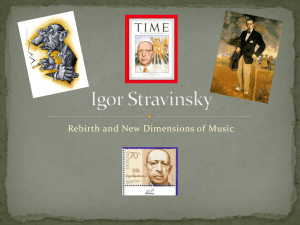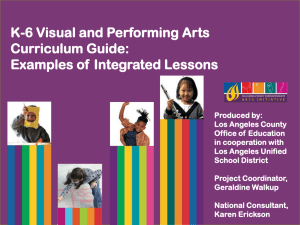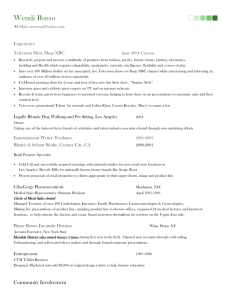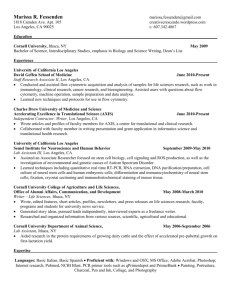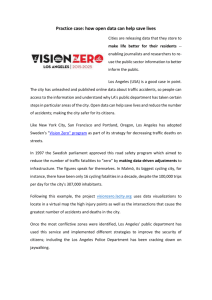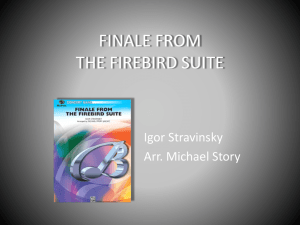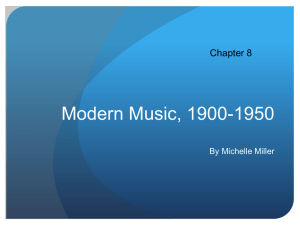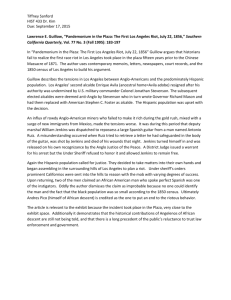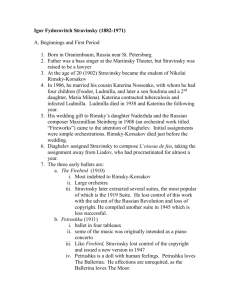The LA Passage of “Rite” by Lorin Johnson The 2013 season marks
advertisement
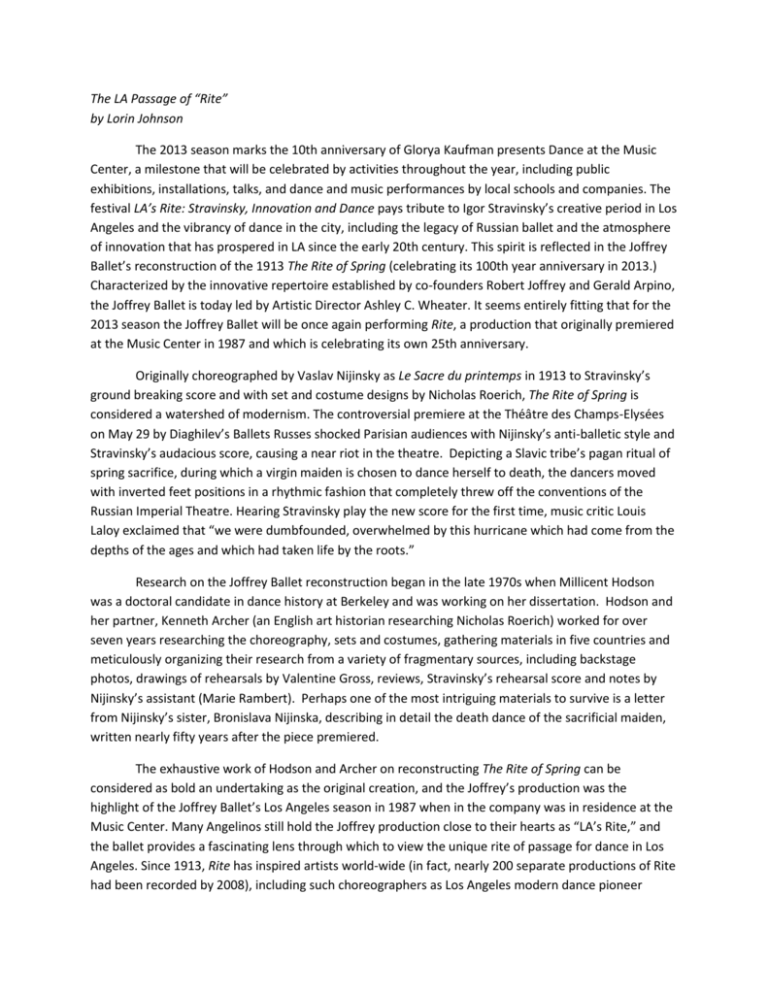
The LA Passage of “Rite” by Lorin Johnson The 2013 season marks the 10th anniversary of Glorya Kaufman presents Dance at the Music Center, a milestone that will be celebrated by activities throughout the year, including public exhibitions, installations, talks, and dance and music performances by local schools and companies. The festival LA’s Rite: Stravinsky, Innovation and Dance pays tribute to Igor Stravinsky’s creative period in Los Angeles and the vibrancy of dance in the city, including the legacy of Russian ballet and the atmosphere of innovation that has prospered in LA since the early 20th century. This spirit is reflected in the Joffrey Ballet’s reconstruction of the 1913 The Rite of Spring (celebrating its 100th year anniversary in 2013.) Characterized by the innovative repertoire established by co-founders Robert Joffrey and Gerald Arpino, the Joffrey Ballet is today led by Artistic Director Ashley C. Wheater. It seems entirely fitting that for the 2013 season the Joffrey Ballet will be once again performing Rite, a production that originally premiered at the Music Center in 1987 and which is celebrating its own 25th anniversary. Originally choreographed by Vaslav Nijinsky as Le Sacre du printemps in 1913 to Stravinsky’s ground breaking score and with set and costume designs by Nicholas Roerich, The Rite of Spring is considered a watershed of modernism. The controversial premiere at the Théâtre des Champs-Elysées on May 29 by Diaghilev’s Ballets Russes shocked Parisian audiences with Nijinsky’s anti-balletic style and Stravinsky’s audacious score, causing a near riot in the theatre. Depicting a Slavic tribe’s pagan ritual of spring sacrifice, during which a virgin maiden is chosen to dance herself to death, the dancers moved with inverted feet positions in a rhythmic fashion that completely threw off the conventions of the Russian Imperial Theatre. Hearing Stravinsky play the new score for the first time, music critic Louis Laloy exclaimed that “we were dumbfounded, overwhelmed by this hurricane which had come from the depths of the ages and which had taken life by the roots.” Research on the Joffrey Ballet reconstruction began in the late 1970s when Millicent Hodson was a doctoral candidate in dance history at Berkeley and was working on her dissertation. Hodson and her partner, Kenneth Archer (an English art historian researching Nicholas Roerich) worked for over seven years researching the choreography, sets and costumes, gathering materials in five countries and meticulously organizing their research from a variety of fragmentary sources, including backstage photos, drawings of rehearsals by Valentine Gross, reviews, Stravinsky’s rehearsal score and notes by Nijinsky’s assistant (Marie Rambert). Perhaps one of the most intriguing materials to survive is a letter from Nijinsky’s sister, Bronislava Nijinska, describing in detail the death dance of the sacrificial maiden, written nearly fifty years after the piece premiered. The exhaustive work of Hodson and Archer on reconstructing The Rite of Spring can be considered as bold an undertaking as the original creation, and the Joffrey’s production was the highlight of the Joffrey Ballet’s Los Angeles season in 1987 when in the company was in residence at the Music Center. Many Angelinos still hold the Joffrey production close to their hearts as “LA’s Rite,” and the ballet provides a fascinating lens through which to view the unique rite of passage for dance in Los Angeles. Since 1913, Rite has inspired artists world-wide (in fact, nearly 200 separate productions of Rite had been recorded by 2008), including such choreographers as Los Angeles modern dance pioneer Lester Horton, who presented his unique version of Stravinsky’s score in 1937 at the Hollywood Bowl. In this sense, The Rite of Spring offers a bridge between past and future that is unique to Los Angeles, highlighting Stravinsky’s creative presence in Los Angeles alongside the dance experimentation that occurred in the city. From its early history, Los Angeles offered the lure of “instant transformation,” where artists could find a fresh creative voice within the diverse mosaic of the community. Such was the case with Igor Stravinsky, who first moved to the city in 1940 and spent more time living in Los Angeles than in any other city in the world. Stravinsky had already toured Los Angeles as early as 1935 and had a network of friends and many exciting possibilities for new ventures, including prospects to work in film with Charlie Chaplin. Stravinsky also believed the fair climate of Southern California would remedy his poor health. He stated that “It seemed a good place to begin a new, clean-slate life.” In Los Angeles, he was surrounded by artists, writers, and musicians, including Thomas Mann, Arthur Rubinstein, Aldous Huxley, Christopher Isherwood, Nadia Boulanger, George Balanchine, and Adolph Bolm. Stravinsky had known Balanchine since 1925 when they worked together on The Song of the Nightingale in Paris, and Bolm since 1910 when he performed a solo role in The Firebird with the Ballets Russes. Stravinsky relied heavily on Bolm in order to adapt to the lifestyle of Los Angeles. In fact, Stravinsky agreed to conduct Bolm’s 1940 version of The Firebird in exchange for a letter of reference for American citizenship. Balanchine and Bolm were part of a Los Angeles dance scene that had been burgeoning since 1915, when Ruth St. Denis and Ted Shawn founded their groundbreaking school and company, Denishawn. In the following decades, Los Angeles was a mecca of dance experimentation. Traveling companies carried the latest European avant-garde aesthetics and a number of important Russians immigrated to Los Angeles following tours of Diaghilev’s Ballets Russes (such as Bolm and Bronislava Nijinska). In her book Dancing in the Sun: Hollywood Choreographers 1915-1937, Naima Prevots notes that by the 1930s thousands of dancers were training and performing in Los Angeles, and a headline from the Los Angeles Times in 1929 even stated “L.A. Takes Lead as Dance Center.” Though Balanchine eventually returned to New York City, his work in Hollywood films during the 1930s-1940s was significant. Against this backdrop, he and Stravinsky visited on an almost daily basis, with Stravinsky attending film rehearsals and Balanchine accompanying Stravinsky to the Disney studios for a prerelease screening of Fantasia. Their bi-coastal relationship featured informal rehearsals in Stravinsky’s home, which was also the site of important discussions about future works. In 1954 while the New York City Ballet was performing in Los Angeles, they conceived one of their most important works, Agon. Their creative relationship was both prolific and durable, perhaps partially due to the sense of humor they shared, illustrated by an early conversation between the two when Ringling Brothers Circus requested a ballet, Circus Polka. According to Balanchine, he approached Stravinsky to compose by asking: “I wonder if you’d like to do a little ballet with me, a polka perhaps.” “For whom?” Stravinsky asked. “For some elephants,” Balanchine replied. “How old?” inquired Stravinsky. “Very young,” was Balanchine’s reply. After a pause, Stravinsky said: “All right. If they are very young elephants, I will do it.” The film industry provided a goldmine of opportunity and attracted high profile Russian ballet stars to California. Former Ballets Russes company member Theodore Kosloff, who appeared in many Hollywood films, was also a regular at the Hollywood Bowl (where Bolm was the resident ballet master.) In Los Angeles, Kosloff introduced the training and aesthetics from the Russian Imperial School. When he opened the Kosloff School of Imperial Russian Ballet one of his students was Agnes de Mille. Kosloff created his staging of Stravinsky’s Petrouchka in 1937, arranging rehearsals during radio broadcasts of Stravinsky’s performances so that the correct tempo would be set! On the centenary of The Rite of Spring, it is interesting to reflect upon an American choreographer who was born closer to home and yet who could not help but be influenced by Stravinsky’s score and Russian modernism—Lester Horton. Horton is one of LA’s great dance success stories, having created a dance company in Los Angeles that forged new pathways in modern dance, rivaling companies in New York with its progressive vision. Horton’s fascination with American Indian arts and artifacts was later combined with his an interest in dance that arose upon witnessing performances of Denis and Shawn in the 1920s. Horton first came to Los Angeles in 1928 to present his work, The Song of Hiawatha, and during the next decade Horton witnessed experimental dance in LA ranging from German expressionism to the Russian avant-garde. Horton’s California Ballets premiered an evening of his work at the Shrine Auditorium in 1934, and the company existed in various forms until 1960 (Horton Dance Group and then Dance Theatre of Los Angeles with Bella Lewitzky.) In 1937, Horton was commissioned by the Hollywood Bowl to choreograph Le Sacre du printemps to Stravinsky’s score, a major launching point for Horton’s company and career. This was the sixth production of Sacre created internationally. Visually, Horton’s Sacre was more uplifting than previous versions, designed in bright yet earthy tones—reds, yellows, blues and browns that were offset by geometric lines, adding a touch of abstract formality to the sensuality of exposed midriffs and the men’s bare chests. As Prevots describes: “This was a ritual of spring that celebrated a California landscape, where flowers bloomed all year and the sun was only intermittently broken with rain and gentle cold. The energy of spring was not a sudden awakening but a continuance of the eternal promise of a utopian environment.” Though Horton’s production received complimentary reviews from the press, the audience’s reaction at the Bowl ranged from nervous giggles to outrage, bringing to mind the controversy of the original 1913 Rite. Horton’s choreography, described as tribal and erotic, was difficult for many in the audience to digest alongside the dissonance of Stravinsky’s music. Bella Lewitzky, who joined Horton’s group in 1934 and performed the role of the Chosen One, stated that the “audience reaction was violent and controversy raged pro and con. I remember the pounding rhythms and a great deal of angularity.” However, the performance at the Hollywood Bowl heralded Horton as a major Los Angeles based choreographer, and artists inspired and trained by Horton went on to change the face of dance in America, including Lewitzky (whose own Los Angeles company existed for some thirty years), Carmen de Lavallade, Alvin Ailey, James Truitte and others. Today, countless artists continue to be inspired by Stravinsky’s score and the passage of Rite continues around the world. Many productions of Rite have been created since Horton’s, and several have traveled through Los Angeles, from Glen Tetley’s 1974 version for American Ballet Theatre (danced by this author) to Shen Wei’s in 2003. Yet none resonate with LA audiences quite like the Joffrey Ballet’s, welcomed back to LA for its 25th anniversary as we begin the 2013 festival! Lorin Johnson, Artistic Advisor for LA’s Rite
